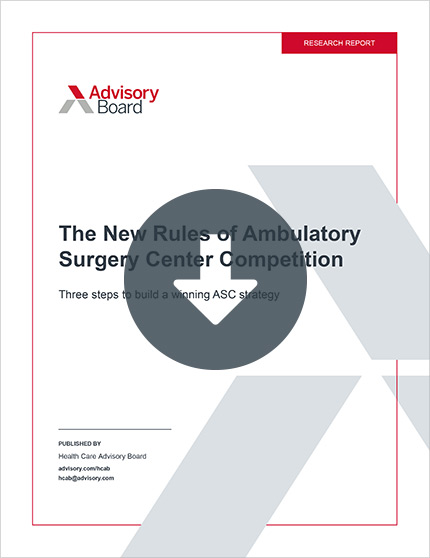Auto logout in seconds.
Continue LogoutConscious sedation is an anesthetic technique intended to leave patients in a "gray zone" between consciousness and unconsciousness, but little is known about how often patients remember painful procedures that occurred while they were sedated—or how damaging such memories may be, Kate Johnson reports for the New York Times' "Well."
Learn the new rules of ambulatory surgery competition
During a routine gastroscopy, Kate Johnson woke up terrified and made a "violent struggle" before blacking out again. After the fact, she was "plagued by my distressing memories" and "diagnosed with acute stress disorder." Writing for the New York Times' "Well," Johnson describes her experience under what's called "conscious sedation"—and how it can lead to trauma for some patients.
What is conscious sedation?
Conscious sedation is becoming increasingly common in health care, as it often doesn't require an anesthesiologist, OR, or even a hospital to administer, Johnson reports.
Andrew Davidson, head of anesthesia research at the Murdoch Children's Research Institute in Melbourne, Australia, said there's no single definition of conscious sedation and it often if achieved through a cocktail of pain control medicines, anxiety control medicines, and amnesia inducing medicines that vary in strength based on the patient, procedure, and provider.
While general anesthesia is intended to ensure the patient experience no awareness, pain, or memory of the procedure, conscious sedation is less defined. "[T]he boundaries between consciousness and unconsciousness are blurred, where patients are sometimes expected to be semi-awake and responsive, and where their distress could potentially be ignored, because amnesia usually sets in," Johnson reports.
Davidson described conscious sedation as "an art." He explained, "Some people say it's actually harder to do than general anesthetic, because it's actually more difficult to titrate the drugs to get exactly what you want."
According to Davidson, most physicians recognize patients will be in distress during the procedure, but they to conscious sedation is amnesia. Physicians are "relying on the fact that most are not going to remember it," Davidson said.
'Pure terror'
But that's not what happened to Johnson, when she went in for her gastroscopy.
After succumbing to unconsciousness, Johnson writes that "something went wrong ... I was awake too soon, flailing and crying." She continued, "I put up a violent struggle on the table: gagging and choking, trying to scream, fighting to pull the medical device out of my esophagus."
Johnson recalls hearing someone yell "Hold her arms!" and then "fe[eling] hot tears, and pure terror" before she went back under.
This isn't the first time Johnson has woken up under conscious sedation, but it is the first time the trauma of her experience stayed with her.
Despite receiving a benzodiazepine called midazolam, "known for its superior amnestic effects," Johnsoon writes, "the fight-or-flight panic that had ensued was seared into my memory." She continued, "A terrifying sense of doom enveloped me in the following days, as I kept reliving a routine medical test that my brain had registered, not unreasonably, as a physical assault."
Undesired awareness
Johnson experienced what's called "undesired awareness" during her surgery—a phenomenon in which people remember disturbing experiences while under conscious sedation.
Since the incident, she's been diagnosed with acute stress disorder, a transient form of post-traumatic stress disorder (PTSD).
According to a study led by George Mashour, a neuroanesthesiologist at the University of Michigan, just three out of every 10,000 people report undesired awareness from nongeneral anesthesia, while two out of every 10,000 report it under general anesthesia.
While there has been extensive research on anesthesia awareness under general anesthesia, not much is known about the impact anesthesia awareness has on people under conscious sedation.
In fact, it's not known if patients who do forget the undesired awareness could still experience nightmares and anxiety according to Aeyal Raz, an anesthesiologist at the University of Wisconsin. "There's plenty of evidence" that humans can form implicit or subconscious memories under anesthesia even if they don't have an explicit memory of the surgery, he said. "There is a trace of the event, a memory, left in the brain. However, it cannot be accessed with conscious thoughts and the person does not recall the learning event. Nonetheless, it may affect future feelings and behavior."
Raz is conducting an ongoing study to observe the link between anesthesia awareness and memory formation.
"The numbers are too small to have conclusive results yet, so I should be careful with the interpretation, but we've had a small number of recall episodes, with most of these episodes related to PTSD symptoms, mostly to sleep problems, at 30 days," he said. He added that a number of patients were aware during the procedure but didn't remember it later, and that it's too early to determine if they're at an increased risk of developing PTSD.
Jackie Andrade, a psychologist at the University of Plymouth, said, "It seems plausible that negative experiences during surgery could reduce patients' well-being on recovery, but it is hard to prove."
However, Davidson argued that the evidence for memory forming during anesthesia is "very mixed, and it is a very long bow to pull to say it has long lasting effects."
Raz said when he speaks to patients about conscious sedation, he warns them they may be awake and may remember what's happening to them, though most patients don't. "I hope that this allows them some control of the situation and a better understanding, which may help in preventing PTSD," he said (Johnson, "Well," New York Times, 1/30).
The new rules of ambulatory surgery competition
In markets across the country, hospital and health system leaders are witnessing massive growth in the lucrative but highly competitive market for ambulatory surgery.
Use this report to implement a dedicated and winning ASC strategy to compete against new and traditional competitors alike.
Don't miss out on the latest Advisory Board insights
Create your free account to access 1 resource, including the latest research and webinars.
Want access without creating an account?
You have 1 free members-only resource remaining this month.
1 free members-only resources remaining
1 free members-only resources remaining
You've reached your limit of free insights
Become a member to access all of Advisory Board's resources, events, and experts
Never miss out on the latest innovative health care content tailored to you.
Benefits include:
You've reached your limit of free insights
Become a member to access all of Advisory Board's resources, events, and experts
Never miss out on the latest innovative health care content tailored to you.
Benefits include:
This content is available through your Curated Research partnership with Advisory Board. Click on ‘view this resource’ to read the full piece
Email ask@advisory.com to learn more
Click on ‘Become a Member’ to learn about the benefits of a Full-Access partnership with Advisory Board
Never miss out on the latest innovative health care content tailored to you.
Benefits Include:
This is for members only. Learn more.
Click on ‘Become a Member’ to learn about the benefits of a Full-Access partnership with Advisory Board
Never miss out on the latest innovative health care content tailored to you.


